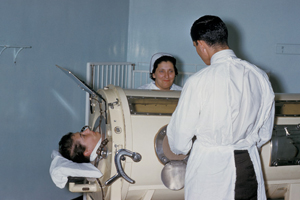Polio Vaccine Demonstrates Importance of Immunization

Pictures of polio patients enclosed in iron lungs were common during the 20th century.
No one likes shots. But the diseases prevented by vaccinations, like polio, are more than a prick in the arm. Images of former President Franklin D. Roosevelt wheelchair bound and children infected with polio lying in iron lungs or with leg braces are reminders of how devastating polio was.
Richard Lampe, M.D., chairman of the Department of Pediatrics, said parents feared the disease and many would not let their children out of the house.
“I grew up in an era when every summer parents were afraid of their children contracting polio,” Lampe said. “Parents were afraid to let children use swimming pools in the summer for fear of getting polio. I can remember going to a church on a Sunday receiving a sugar cube with the oral polio vaccine as part of a community effort to halt the disease.”
A 1916 polio epidemic in the U.S. killed 6,000 people and paralyzed 27,000 more. In the early 1950s, there were more than 20,000 cases of polio each year. At its peak, poliomyelitis or polio, paralyzed and killed up to half a million people each year.
Dr. Jonas Salk developed the first effective polio vaccine in 1952. On Feb. 23, 1954, a group of children from Arsenal Elementary School in Pittsburgh received the first injections of the polio vaccine.
Lampe said polio is caused by a virus and enters the body through the mouth. In the ‘50s it caused paralysis or death, usually by paralyzing the muscles that helped patients breathe.
“I practice in the United States where the last case of Polio was in 1979,” Lampe said. “But polio has not been eliminated from the rest of the world. The only way to be protected is to receive the vaccine.”
Lampe said children should get four doses of the polio vaccine at these ages:
- a dose at 2 months
- a dose at 4 months
- a dose at 6-18 months
- a booster dose at 4-6 years
Some combination vaccines (several different vaccines in the same shot) contain the polio vaccine. Children getting these vaccines may need one more (a fifth) dose.
“Who would not want their child to be protected from a preventable cause of paralysis or death,” Lampe said. “Vaccines are safe and effective and are our most effective way to prevent polio. Iron lungs and respirators belong in museums—not to treat polio when it is preventable.”
As a result of the polio vaccine, the World Health Organization certified the Americas polio free in 1994; the Western Pacific followed in 2000, and Europe in 2002. Since it was first administered in 1954, the method of delivering the vaccine has changed from an injection to the oral polio vaccine and the actual make-up of the vaccine has been altered.
“As a child, I remember a neighbor friend who contracted polio and was paralyzed the rest of his life and had to walk with crutches,” Lampe said. “I can guarantee you that his mother wished the polio vaccine came five years earlier.”
Related Stories
Celebrating Veterans: TTUHSC’s General Martin Clay’s Legacy of Service and Leadership
From his initial enlistment in the Army National Guard 36 years ago to his leadership in military and civilian health care management roles, Major General Martin Clay’s career has been shaped by adaptability, mission focus and service to others.
Texas Tech University Health Sciences Center School of Nursing Named Best Accelerated Bachelor of Science in Nursing Program in Texas
The TTUHSC School of Nursing Accelerated Bachelor of Science in Nursing (BSN) program has been ranked the No. 1 accelerated nursing program in Texas by RegisteredNursing.org.
TTUHSC Names New Regional Dean for the School of Nursing
Louise Rice, DNP, RN, has been named regional dean of the TTUHSC School of Nursing on the Amarillo campus.
Recent Stories
TTUHSC Cancer Researcher Honored by National Academy of Inventors
C. Patrick Reynolds, M.D., Ph.D., director of the School of Medicine Pediatric Cancer Research Center at TTUHSC, has dedicated his life as a researcher to developing treatments for childhood cancers.
TTUHSC School of Nursing Celebrates 10 Years of the Veteran to BSN Program
The TTUHSC School of Nursing recognized the 10-year anniversary of the Veteran to Bachelor of Science in Nursing (VBSN) program during the fall 2025 commencement ceremonies held Dec. 13 in Lubbock, Texas.
TTUHSC Dean to be Inducted into the National Academies of Practice as Distinguished Fellow
Gerard E. Carrino, Ph.D., MPH, dean of the TTUHSC Julia Jones Matthews School of Population and Public Health, will be inducted into the National Academies of Practice (NAP) as a Distinguished Fellow of the Public Health Academy.
